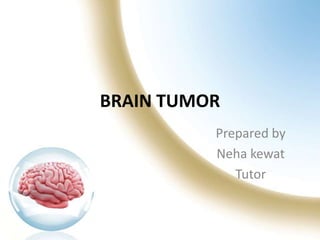BRAIN TUMOR prepared by MS. Neha kewat.pptx
- 1. BRAIN TUMOR Prepared by Neha kewat Tutor
- 2. BRAIN TUMOR A brain tumor occupies space within the skull, growing as a spherical mass or diffusely infiltrating tissue. The effects of brain tumors are caused by inflammation, compression, and infiltration of tissue. A variety of physiologic changes result, causing any or all of the following pathophysiologic events: 1.Increased intracranial pressure (ICP) and cerebral edema 2.Seizure activity and focal neurologic signs 3. Hydrocephalus 4. Altered pituitary function Neoplastic lesions in the brain ultimately cause death by increasing ICP and impairing vital functions, such as respiration.
- 3. BRAIN TUMORS ARE CLASSIFIED AS :- 1.Primary Tumor :- Primary brain tumors originate from cells within the brain. In adults, most primary brain tumors originate from glial cells (cells that make up the structure and support system of the brain and spinal cord) and are supratentorial (located above the covering of the cerebellum). Primary tumors progress locally and rarely metastasize outside the CNS.
- 4. CLASSIFICATION OF PRIMARY BRAIN TUMORS ACCORDING TO ORIGIN :- I. Intracerebral tumors A. Gliomas :- infiltrate any portion of the brain ;most common type of brain tumor 1. Astrocytomas (grades I and II) :- The tumour which arises from astrocytes (star shaped glial cell).
- 5. 2. Glioblastoma ( astrocytoma grade III and IV) :- These are grade 3 and grade 4 astrocytoma.
- 6. 3.Oligodendroglioma ( low and high grades) :- This rare tumour arises from cells that make the fatty substance that covers and protects nerve, usually occurs in the cerebrum.
- 7. 4. Ependymoma (grade I and IV) :- The tumour that arises from cells that line the ventricles or the central canal of the spinal cord. More common in children. 5. Medulloblastoma :- This tumour arises in the cerebellum, sometimes called as primitive neuroectodermal tumour
- 8. II. Tumors arisng from supporting structures A. Meningioma - This tumour arises in the meninges.
- 9. B. Acoustic neuroma- Tumour that arise in the cranial nerve VIII.
- 10. C. Schwannoma- A tumour that arises from a Schwann cell of neuron. D. Pituitary adenoma- Tumour that arises in the pituitary gland.
- 11. E. Pineal region tumour- this rare brain tumour arises in or near the pineal gland. F. Germ cell tumour of the brain- this type of tumour arises from a germ cell.
- 12. III. Developmental Tumors a. Angiomas: Masses composed largely of abnormal blood vessels, are found either in or on the surface of the brain. They occur in the cerebellum.
- 13. b. Craniopharyngioma: This type of tumour grows at the base of the brain, near the pituitary gland.
- 14. c. Dermoid tumour: It is a sac like growth that is present at birth, contains structures such as hair, fluid, teeth and skin glands that can be found inside the skull. d. Epidermoid tumour: This tumours occurs when the normal developmental cells are trapped within the growing brain. It has a thin outer layer of epithelial cells surrounding fluid, keratin and cholesterol. IV. Metastaic lesions
- 15. 2.Secondary Tumor :- Secondary, or metastatic, brain tumors develop from structures outside the brain and are twice as common as primary brain tumors. Metastatic lesions to the brain can occur from the lung, breast, lower gastrointestinal tract, pancreas, kidney, and skin (melanomas) neoplasms.
- 16. CLINICAL MANIFESTATIONS :- 1.Increased Intracranial Pressure 2.Headache 3.Vomiting 4.Visual Disturbance 5.Seizures
- 17. LOCALISED SYMPTOMS :- Many tumors can be localized by correlating the signs and symptoms to specific areas in the brain , as follows : 1. A frontal lobe tumor may also produce changes in emotional state and behaviour as well as an apathetic mental attitude. The patient often becomes impulsive, inappropriate in speech, gestures and behavior. 2. A parietal lobe tumor may cause deacreased sensation on the opposite side of the bady Or genralized seizures.
- 18. 3.A temporal lobe tumor may cause seizures as well as psychological disorders. 4.An occipital lobe tumors produces visual manifestation: contralateral homonymous hemianopsia ( visual loss in half of the visual field on the opposite side of the tumor) and visual hallicinations. 5.A cerebellar tumor causes dizziness, an ataxic Or staggering gait with a tendency to fall toward the side of the lesion; marked muscle incoordination and nystagmus, usually in the horizontal direction.
- 19. 6. A cerebellopontine angle tumor - Tinnitus and Vertigo, Nerve deafness, Numbness and tingling of the face and tongue. Brainstem tumors may be associated with cranial nerve deficits along with complex motor and sensory function impairments.
- 20. DIAGNOSTIC EVALUATIONS :- 1.Neurological Examination 2.CT scan and MRI 3.PET ( Positron emission tomography) 4.EEG
- 21. MANAGEMENT 1.Surgical management A. Craniotomy 2.Radiation therapy 3.Chemotherapy 4.Pharmacological therapy





















